|
|
|
 |
The Karakoram Highway |  |
|
Travelling through the past As the old saying goes, when you are given lemons, you make lemonade. So when my flight to Gilgit was cancelled, I chose to take a two day drive north up the historic Karakoram highway. The highway was built on the old Silk Road route and now connects Driving west from The Highway officially starts at Once you leave the towns the road opens up. This is where the action really is. I would give an even chance to the most fearless formula one driver if he was given a tank against these drivers. The road soon becomes an endless series of S curves with sheer rock rising up on one side and a dead drop on the other. Forget a center line, cars drive where they can. Overtaking is a game to these men. We passed in the other lane, on the shoulder, and in one instance, in the opposite shoulder as we overtook a car that was overtaking. Passing on the inside line of a blind corner while going uphill is common. Honking to alert oncoming traffic to your invisible presence seems to be the rule of the road. C’est la vive. But in this mad race you need to be patient as well. I witnessed the most massive display of unintelligence I could imagine. We hit a traffic jam; inevitably cars pull up in the oncoming lane to jockey for a better position when it breaks. This leads to a rugby scrum of cars five abreast all in gridlock. Eventually I noticed a truck that had fallen over the side and was now 20 meters down from the road facing back up stuck in the trees. I saw no evidence of anyone helping, but have the passengers had left their cars on the road to get out and look. When the situation did become passable the oncoming traffic had reacted in a similar matter, the entire road was blocked, in both directions, and somehow cars had to lurch forward to find space to advance. We were stopped for almost an hour. Other passengers and drivers would laugh at the chaos and use their hands out the window to try and steal positions. My driver slept through the gridlock and then I think tried to ram his car into a laughing drivers hand as he tried to overtake us with a daring inside charge. We even overtook an ambulance in the rush out. Throughout all of this the scenery is remarkable. The towns are alive with colour and excitement. The mountains loom in the distance in all directions. The river splashes and cuts through the rocks below. It is an amazing experience. Once we hit the more mountainous areas we even had to slow down for cricket games since the only flat area for bowling is found on the road. It was strangely reminiscent of my younger days playing street hockey. The motel I spent the night at was a quick swerve off the road and I was able to walk down by the river and climb up a rocky outcrop to see the valley at dusk. The following day the driver and I were old friends and he stopped to show me scenic points along the way. The car ride north is definitely the way to get there. However, next time I may spend a week and stop at every little town along the way. This road has been used for thousands of years. I am delighted to have crossed its path. PS Mom, I have obviously arrived in Gilgit, the family is stiflingly hospitable, almost as if I am an honoured prisoner. You will be happy I am safe. With love, Aaron. |
|
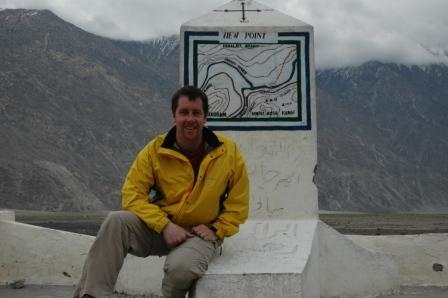
|
The Roof of the World The sign below indicates that this is the roof of the world, three of the globes largest mountain ranges meet at this point, the Himilayas, the Hindu Kish, and the Karakorams. |
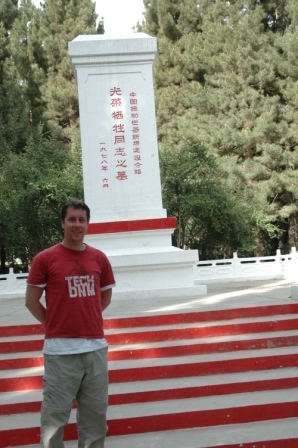
|
Graveyard
A special graveyard and monumnet just outside Gilgit to over 80 Chinese labourers who died in building the highway. |
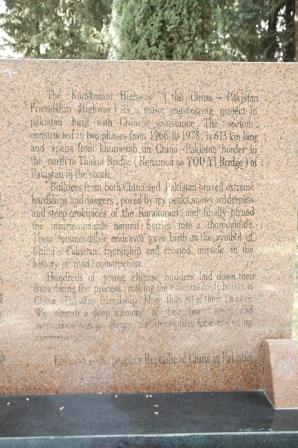
|
Graveyard I don't know if you can read it or not, but it details the information about the Chinese graveyard. You can learn a lot about a culture and people from how they honour their past heroes as well as the common man. |
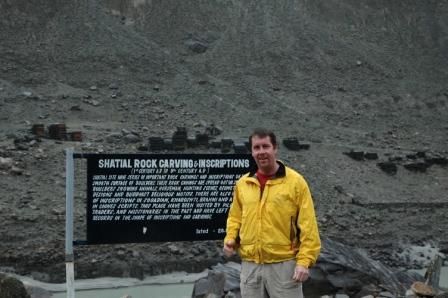
|
Rock Carvings People have been travelling here for over a thousand years. Rock carving was a way of labeling a path and leaving your mark. |
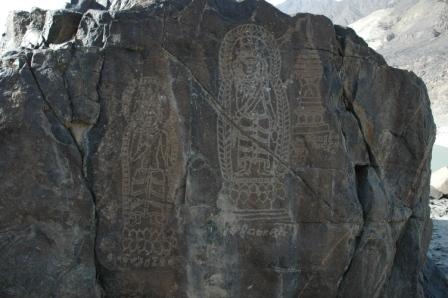
|
Budha Carvings Budhist monks travelled this way in and out of Pakistan from China. Their carvings can be found in abundance in select areas. Although some of the carvings I saw certainly looked refreshed over the years. It keeps the tourists travelling these roads as well. |
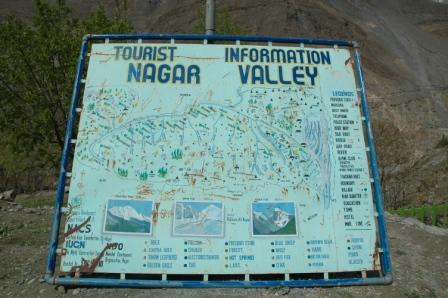
|
Site seeing Further north of Gilgit along the highway is the Racapushi mountain. We sat there and had tea as I asked about climbing it. I was put off by the fact that it is too dangerous from this vantage point and is the 8th largest mountain peak in the world. Still, it is something to ponder while I stir my sugar. |
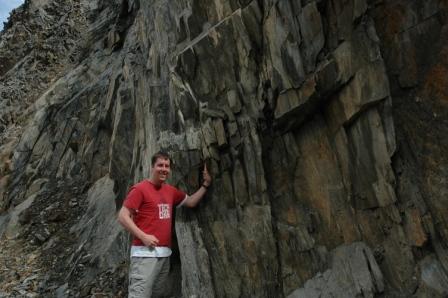
|
Sedimentary Rocks? I also hope the picture shows what I was thinking. Sedimentary rocks form inlayers over centuries as piles of sediment settle and harden. Logic dictates that sediment layers are horizontal. These mountains are still on the move (up) and tectonic plates are coliding. What I was noticing is that the sedimentary layers are not horizontal, not even close, they go almost straight up. I hope I have my geology facts right in this, I may have to ask Sean from soccer to doubel check. |